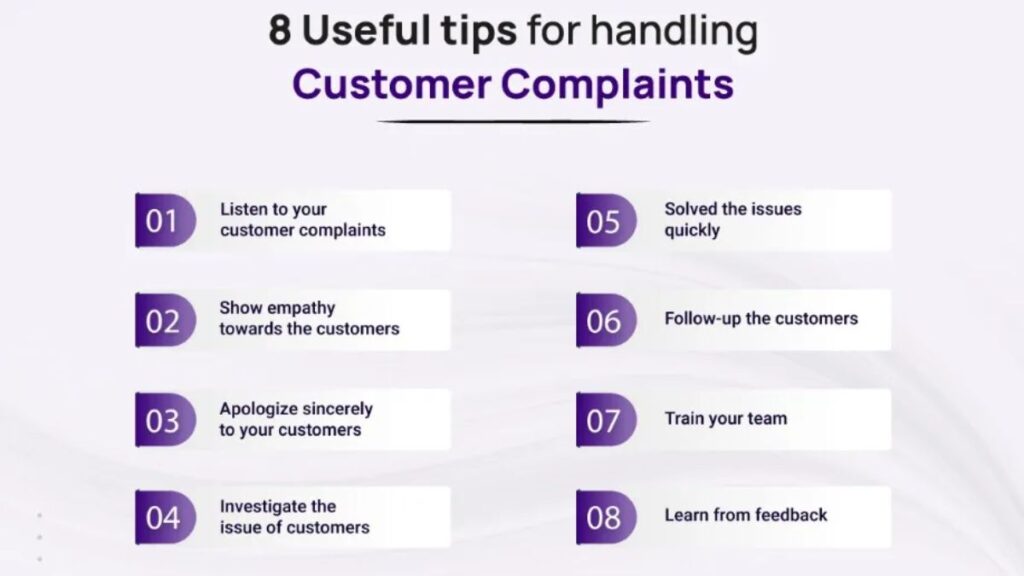Customer complaints are an inevitable part of running any business, regardless of its size or industry. How you handle these complaints can make a significant difference in customer retention, reputation, and the overall success of your brand. Addressing customer concerns effectively can turn a negative experience into a positive one, leading to stronger customer loyalty and satisfaction. In this article, we will explore the best practices for handling customer complaints and transforming potential dissatisfaction into an opportunity for growth and improvement.
Understanding the Importance of Handling Complaints
Before diving into the specific practices for dealing with complaints, it’s essential to understand why addressing customer grievances is so crucial. Customers who have a problem or feel dissatisfied with your product or service are already frustrated. If you fail to respond properly, their frustration can escalate, leading to lost business, bad reviews, and even negative word-of-mouth marketing. On the other hand, when complaints are handled properly, they can serve as valuable feedback, giving you insights into areas that need improvement.
Additionally, a customer who feels heard and valued is more likely to continue doing business with you, even after a problem has occurred. This makes customer complaints a vital aspect of building long-term relationships and improving your brand’s reputation.
Best Practices for Handling Customer Complaints
1. Acknowledge the Complaint Promptly
The first step in addressing any complaint is acknowledging it. This shows the customer that their concern is being taken seriously. Whether it’s a phone call, email, or social media message, ensure you respond to complaints as soon as possible. A prompt acknowledgment can prevent the situation from escalating and shows that you care about their experience.
In today’s fast-paced world, customers expect quick responses. A delayed reply can increase their frustration, leaving them feeling ignored. Even if a resolution will take time, let the customer know you’ve received their complaint and are working on a solution. For example, you can say, “Thank you for reaching out. We are currently reviewing the details of your concern and will get back to you as soon as possible with an update.” This simple act of communication sets the tone for a positive resolution.
2. Stay Calm and Professional
When handling complaints, it’s important to remain calm and composed. Complaints often come from a place of frustration, and customers may express their dissatisfaction in strong or emotional language. However, your response should always remain calm, respectful, and professional, no matter the tone of the complaint.
The way you communicate plays a significant role in diffusing the situation. Avoid taking the complaint personally, and refrain from using defensive language. Instead, focus on understanding the customer’s issue and finding a solution. Using empathetic statements such as, “I understand how frustrating this must be for you” or “I’m sorry you’ve had this experience” can go a long way in calming an upset customer.
3. Listen Actively
Active listening is a cornerstone of effective communication, especially when it comes to handling complaints. Instead of interrupting or rushing to provide a solution, take the time to listen to the customer’s concerns. Let them express their frustration fully before responding. By doing so, you not only gather all the relevant information but also make the customer feel valued and heard.
During the conversation, make sure to paraphrase or repeat back the key points the customer has made. This shows that you are paying attention and genuinely trying to understand their problem. For instance, you can say, “So, what I’m hearing is that the delivery was delayed, and the product didn’t meet your expectations, is that correct?” This ensures that there are no misunderstandings and that you are addressing the correct issue.
4. Empathize with the Customer
Empathy is one of the most powerful tools when handling complaints. Put yourself in the customer’s shoes and imagine how they feel. A customer who has faced a problem with your service or product is likely experiencing some degree of frustration or disappointment. Acknowledging their emotions and showing understanding can help build rapport and make them more receptive to a solution.
Empathizing does not mean agreeing with the complaint or accepting blame unnecessarily. Instead, it means validating their feelings and showing that you understand the inconvenience they’ve experienced. You might say, “I can completely understand why you’d be upset in this situation, and I’m sorry for the trouble it’s caused you.”
5. Apologize Sincerely
Even if the issue wasn’t directly your fault, offering a sincere apology can work wonders in diffusing customer dissatisfaction. A simple apology such as “I’m sorry you’ve had a negative experience with us” shows the customer that you care about their feelings and take responsibility for the impact of the situation.
An apology is not an admission of guilt but a recognition that the customer’s experience was not ideal. It is important to ensure that your apology feels genuine, so customers know that you truly care about resolving their issue. Sincere apologies can often turn a disgruntled customer into a loyal advocate for your brand.
6. Offer a Solution or Compensation
Once you’ve understood the issue, empathized with the customer, and apologized, it’s time to focus on finding a solution. Depending on the nature of the complaint, the resolution may vary. Some issues can be easily resolved with a refund, replacement, or an exchange, while others might require more significant adjustments or accommodations.
If the solution involves compensation, ensure that the offer is reasonable and proportionate to the problem. For example, if a customer has received a faulty product, offering a replacement or a refund is a reasonable resolution. If the complaint involves poor customer service, offering a discount on their next purchase or a complimentary service may help restore their trust in your brand.
Make sure the solution is communicated clearly, and offer alternatives if necessary. For example, you could say, “We can offer you a full refund or a replacement, whichever option works best for you.” This puts the control in the customer’s hands, making them feel more empowered and satisfied with the outcome.
7. Follow Up After Resolution
After the complaint has been addressed, it’s essential to follow up with the customer to ensure they are satisfied with the resolution. A follow-up call, email, or message demonstrates that you care about their experience and are committed to delivering excellent customer service. It also provides an opportunity to ask for feedback on how the process could be improved.
For instance, you could send a message saying, “I just wanted to check in and see if everything is working well with your new product. If there’s anything else we can assist you with, please don’t hesitate to let us know.” This proactive approach not only enhances customer satisfaction but also strengthens the customer’s loyalty.
8. Use Complaints as Feedback for Improvement
Every complaint presents an opportunity for growth. Instead of seeing complaints as just problems to be solved, view them as a valuable source of feedback. Complaints can highlight areas of your business that need attention, whether it’s a product quality issue, a flaw in your customer service, or a misunderstanding in your marketing materials.
By tracking the types of complaints you receive and identifying patterns, you can make informed decisions to improve your business. For example, if multiple customers complain about delayed deliveries, you may need to assess your supply chain and find ways to streamline the process. If customers are unhappy with the user experience on your website, consider making design or functionality improvements.
Regularly reviewing customer feedback and complaints ensures that you’re continuously improving and adapting to the needs of your customers.
Conclusion
Handling customer complaints is an essential skill that can make or break your business’s reputation. By acknowledging complaints quickly, staying calm and professional, listening actively, and offering genuine solutions, you can turn potentially negative situations into positive outcomes. Empathy, sincere apologies, and follow-up communication are key to maintaining customer loyalty and building long-term relationships.
Most importantly, never underestimate the value of customer feedback. Complaints are an opportunity for growth, improvement, and the chance to enhance your business practices. When you handle complaints effectively, not only do you resolve the current issue, but you also build a more resilient and customer-focused brand. Adopting these best practices will ensure that your company is well-equipped to turn complaints into chances for improvement and deeper customer connection.



